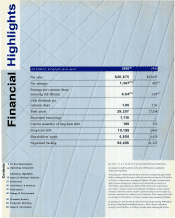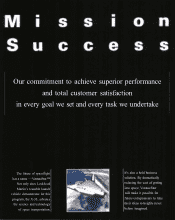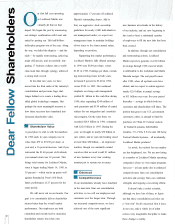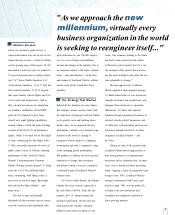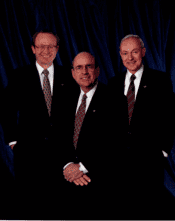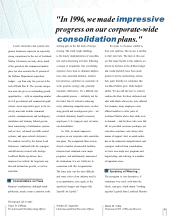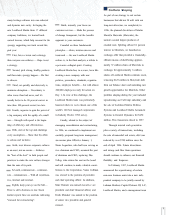Lockheed Martin 1996 Annual Report Download - page 5
Download and view the complete annual report
Please find page 5 of the 1996 Lockheed Martin annual report below. You can navigate through the pages in the report by either clicking on the pages listed below, or by using the keyword search tool below to find specific information within the annual report.
Mission Success
From our customers' point of view, a
major achievement was our record of con-
tinued mission success — which we define
on the opening page of this report. Of 307
measurable events last year, we realized a
93 percent mission success rating, includ-
ing 7 of 7 Space Shuttle launches, 4 of
4 Peacekeeper launches, 11 of 11 fleet bal-
listic missile launches, 13 of 13 expend-
able space launch vehicle flights, and 8 of
8 new spacecraft deployments. Add to
that, our mission success in completing,
on schedule, installation of LANTIRN
pods on F-14 Tomcats to give Navy
aircraft new night fighting capabilities;
joining without a hitch the major fuselage
sections of the first F-22 air dominance
fighter, which is on track for its first flight
in May; conducting the first flight of the
C-130J; successful operation of a new air
traffic control center in Taiwan; stunning
performance of the Advanced Threat
Infrared Countermeasures/Common
Missile Warning System during U.S. Army
tests; the F-16's five millionth flight
hour; completing, with flying colors, a
test series on our new super lightweight
fuel tank for the Space Shuttle — and
many more.
The key to these and literally
thousands of other mission success stories
were the countless tasks performed with
"As we approach the new
millennium, virtually every
business organization in the world
is seeking to reengineer itself..."
great dedication by our 190,000 employ-
ees. In a year of major consolidation,
turmoil and change in the industry, this is
an enormous tribute to the talent, commit-
ment — and concentration — of the men
and women of Lockheed Martin, without
whom, none of this would have been
possible.
The Strategy That Worked
Behind all the statistics are some impor-
tant strategic actions we have taken with
the objectives of keeping Lockheed Martin
on its growth curve and building share-
holder value. As we approach the new
millennium, virtually every business orga-
nization in the world is seeking to
reengineer itself to adapt to a changing
environment and seek a competitive edge
in the emerging global marketplace.
But perhaps no industry has had a greater
imperative to change than aerospace
and defense which, of course, comprises
a substantial part of Lockheed Martin's
business base.
As is now widely known, the defense
industry has been severely impacted by
the end of the Cold War. Since the late
eighties, the U.S. defense budget has
declined significantly, and the procure-
ment portion has virtually collapsed —
falling by more than two-thirds in real
terms. Any company looking to the future
has had to take at least the basic thrust
of Darwin's point seriously that "it is not
the strongest of the species that survives,
nor the most intelligent, but rather the one
most adaptable to change."
Moving aggressively, Lockheed
Martin adopted a three-pronged strategy:
(1) Build market share in core businesses
through investment and acquisitions, and
integrate those businesses to maximize
efficiencies; (2) Move into adjacent
markets through reasonable investment in
selected, closely-related businesses; and
(3) Shed less well-positioned and non-core
businesses through divestiture. In short,
reengineer Lockheed Martin — and
do it fast.
Putting its stake in the ground early,
Lockheed Martin moved aggressively to
pick strong partners in complementary
businesses and at valuations that, in many
cases, were a fraction of those prevailing
today. Capping a series of acquisitions and
mergers since 1993, Lockheed Martin's
strategic combination with Loral, com-
pleted in April 1996, was the perfect fit
to balance our core businesses and
strengthen our competitive position in
faster growing markets.


